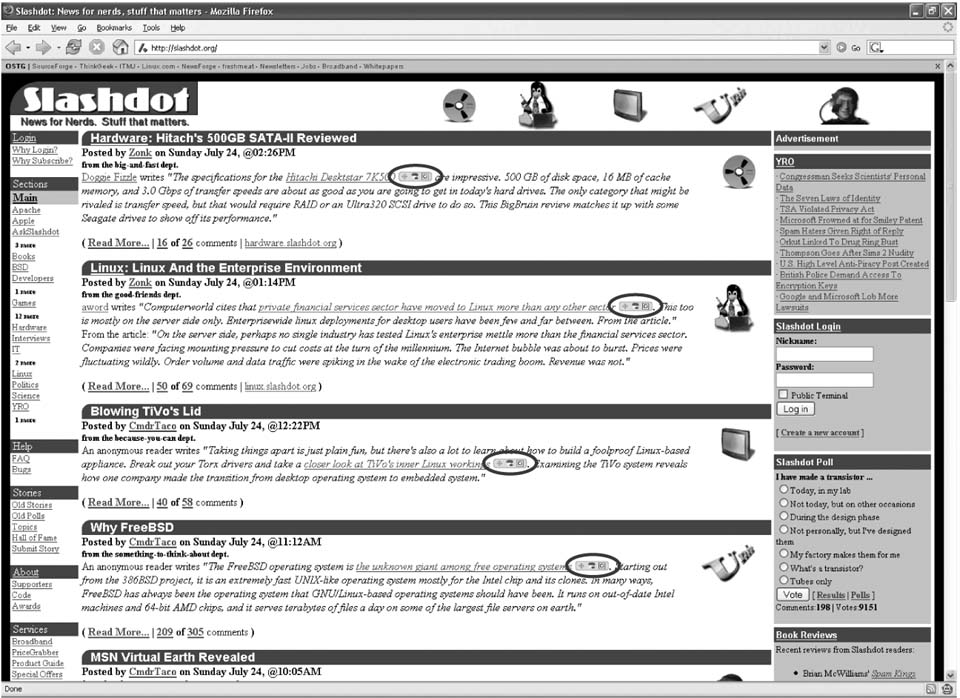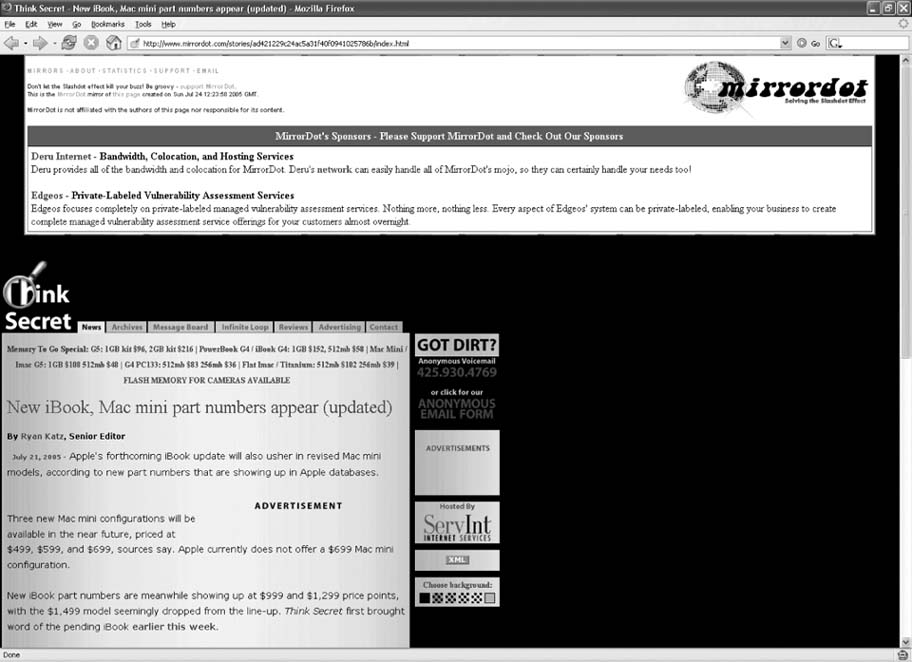How to Avoid the Slashdot Effect with User Scripts
Avoid the Slashdot Effect
Add web cache links to Slashdot articles.
Reading Slashdot is one of my guilty pleasures. It is a guilty pleasure that I share with tens of thousands of other tech geeks. People who have been linked from a Slashdot article report that Slashdot sends as many as 100,000 visitors to their site within 24 hours. Many sites cannot handle this amount of traffic. In fact, the situation of having your server crash after being linked from Slashdot is known as the Slashdot effect.
|
This hack tries to mitigate the Slashdot effect by adding links to Slashdot articles that point to various global web caching systems. Instead of visiting the linked site, you can view the same page through a third-party proxy. If the Slashdot effect has already taken hold, the linked page might still be available in one of these caches.
The Code
This user script runs on all Slashdot pages, including the home page. The script adds a number of CSS rules to the page to style the links we're about to add. Then, it constructs three new links-one to Coral Cache, one to MirrorDot, and one to the Google Cache-and adds them after each external link in the Slashdot article.
Save the following user script as slashdotcache.user.js:
// ==UserScript==
// @name Slashdot Cache
// @namespace http://www.cs.uni-magdeburg.de/~vlaube/Projekte/
GreaseMonkey/
// @description Adds links to web caches on Slashdot
// @include http://slashdot.tld/*
// @include http://*.slashdot.tld/*
// ==/UserScript==
// based on code by Valentin Laube
// and included here with his gracious permission
var coralcacheicon = 'data:image/png;base64,iVBORw0KGgoAAAANSUhEUgAAAA'+
'oAAAAKCAYAAACNMs%2B9AAAAgUlEQVQY042O0QnCQBQEZy0sFiEkVVxa8GxAuLOLgD3cV'+
'RKwAytYf05JkGgGFt7H8nZkG10UgBNwZE0F7j77JiIJGPlNFhGzgwOQd%2FQytrEJdjtb'+
'rs%2FORAqRZBvZBrQxby2nv5iHniqokquUgM%2FH8Hadh57HNG05rlMgFXDL0vE%2FL%2'+
'BEXVN83HSenAAAAAElFTkSuQmCC';
var mirrordoticon = 'data:image/png;base64,iVBORw0KGgoAAAANSUhEUgAAAAo'+
'AAAAKCAYAAACNMs%2B9AAAAbklEQVQY05WQMRKEMAwDNzzqUobWv%2BBedvcK3EKZV4km'+
'BiYFE9RYI3mssZIkRjD1Qnbfsvv2uJjdF6AApfELkpDEZ12XmHcefpJEiyrAF%2Fi1G8H'+
'3ajZPjOJVdPfMGV3N%2FuGlvseopprNdz2NFn4AFndcO4mmiYkAAAAASUVORK5CYII%3D';
var googleicon = 'data:image/png;base64,iVBORw0KGgoAAAANSUhEUgAAAAoAAA'+
'AKCAIAAAACUFjqAAAAiklEQVQY02MUjfmmFxPFgAuIxnz7jwNcU9BngSjae%2FbDxJUPj'+
'1z%2BxMDAYKPLlx8u72wswMDAwASRnrjyIQMDw%2BoW3XfbbfPD5SFchOGCHof2nHmPaT'+
'gTpmuEPA8LeR6GsKHSNrp8E1c%2B3Hv2A8QKG10%2BiDjUaRD7Qmsuw51GlMcYnXcE4Aq'+
'SyRn3Abz4culPbiCuAAAAAElFTkSuQmCC';
var backgroundimage = 'data:image/png;base64,iVBORw0KGgoAAAANSUhEUgAAA'+
'DEAAAAOCAYAAACGsPRkAAAAHXRFWHRDb21tZW50AENyZWF0ZWQgd2l0aCBUaGUgR0lNUO'+
'9kJW4AAAC7SURBVEjH7daxDYMwEEbhh11cAxKSKYEV0qeKMgETZBbPkgmYIEqVPisAJZa'+
'QTOPCUprQZYAY8Sb4P11zGcD9dT0BFuhIpx6wt%2FPjnX0BTxEpjako8uLv1%2FvV49xM'+
'CGEBLgqwIlI2dZsEAKDIC5q6RURKwCqgM6ZCa01Kaa0xpgLo1CZLsW23YgcdiANxIH4g%'+
'2FOqTHL%2FtVkDv3EyMMSlAjBHnZoBeATaEsIzTkMxF%2FOoZp2F7O2y2hwfwA3URQvMn'+
'dliTAAAAAElFTkSuQmCC';
function addGlobalStyle(css) {
var head, style;
head = document.getElementsByTagName('head')[0];
if (!head) { return; }
style = document.createElement('style');
style.type = 'text/css';
style.innerHTML = css;
head.appendChild(style);
}
addGlobalStyle('' +
'a.coralcacheicon, a.mirrordoticon, a.googleicon { \n' +
' padding-left: 15px; background: center no-repeat; \n' +
'} \n' +
'a.coralcacheicon { \n' +
' background-image: url(' +coralcacheicon + '); \n' +
'} \n' +
'a.mirrordoticon { \n' +
' background-image: url(' + mirrordoticon + '); \n' +
'} \n' +
'a.googleicon { \n' +
' background-image: url(' + googleicon + '); \n' +
'} \n' +
'a.coralcacheicon:hover, a.mirrordoticon:hover, ' +
'a.googleicon:hover { \n' +
' opacity: 0.5; \n' +
'} \n' +
'div.backgroundimage { \n' +
' display:inline; \n' +
' white-space: nowrap; \n' +
' padding:3px; \n' +
' background:url(' + backgroundimage + ') center no-repeat; \n' +
'}');
var link, anchor, background;
for (var i=0; i<document. links.length; i++) {
link = document. links[i];
// filter relative links
if(link.getAttribute('href').substring(0,7) != 'http://') {
continue;
}
// filter all other links
if(link.parentNode.nodeName.toLowerCase() != 'i' &&
(link.parentNode.nodeName.toLowerCase() != 'font' ||
link.parentNode.color != '#000000' || link.parentNode.size == '2')
&&
(!link.nextSibling || !link.nextSibling.nodeValue ||
link.nextSibling.nodeValue.charAt(1) != '[')) {
continue;
}
// add background
background = document.createElement('div');
background.className = 'backgroundimage';
link.parentNode.insertBefore(background, link.nextSibling);
//add mirrordot link
anchor = document.createElement('a');
anchor.href = 'http://www.mirrordot.com/find-mirror.html?' + link.href;
anchor.title = 'MirrorDot - Solving the Slashdot Effect';
anchor.className = 'mirrordoticon';
background.appendChild(anchor);
//add coral cache link
anchor = document.createElement('a');
anchor.href = link.href;
anchor.host += '.nyud.net:8090';
anchor.title = 'Coral - The NYU Distribution Network';
anchor.className = 'coralcacheicon';
background.appendChild(anchor);
//add google cache link
anchor = document.createElement('a');
anchor.href = 'http://www.google.com/search?q=cache:' + link.href;
anchor.title = 'Google Cache';
anchor.className = 'googleicon';
background.appendChild(anchor);
// add a space so it wraps nicely
link.parentNode.insertBefore(document.createTextNode(' '),
link.nextSibling);
}
Running the Hack
After installing the user script (Tools  Install This User Script), go to http://slashdot.org. In the summary of each article, you will see a set of small icons next to each link, as shown in Figure 2-10.
Install This User Script), go to http://slashdot.org. In the summary of each article, you will see a set of small icons next to each link, as shown in Figure 2-10.
Figure 2-10. Slashdot cache links

The first icon points to the MirrorDot cache for the linked page, the second icon points to the Coral Cache version of the link, and the third points to the Google Cache version. If the linked page is unavailable because of the Slashdot effect, you can click any of the cache links to attempt to view the link. For example, the MirrorDot link takes you to a page on MirrorDot (http://www.mirrordot.com) that looks like Figure 2-11.
The Coral Cache system works on demand: the page is not cached until someone requests it. MirrorDot works by polling Slashdot frequently to find new links before the Slashdot effect takes the linked site down. Google Cache works in conjunction with Google's standard web crawlers, so brand-new pages might not be available in the Google Cache if Google had not indexed them before they appeared on Slashdot.
Figure 2-11. MirrorDot cache of Slashdotted link

